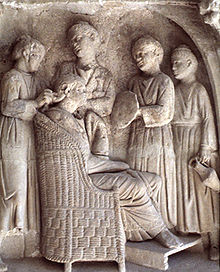Hairdressing and Make-up Artistry Courses Available at James Watt College.
The courses in Hairdressing and Make-up Artistry give you the chance to gain practical experience in the college's own salons.
In addition to the basic Hairdressing skills of cutting, styling, colouring and perming, courses are also offered which allow you to develop your knowledge and skills to a higher level, in response to current industrial demands.
Qualifications in Make-up Artistry will appeal to those interested in providing this service for Film, Television and Theatre.
There are four course levels in Hairdressing::
1: Cosmetology Hairdressing -Begin Hairdressing NPA 4
Available in Full-time and Part-time courses:
There are no entry requirements, although enthusiasm is important.
Entry subject to interview.
Job Op's: Can lead to employment as a salon Assistant
Moving on: NQ 5 Hairdressing
2: Hairdressing NQ 5
Available in Full-time and Part-time courses:
There are no entry requirements, Just an interest.
Entry subject to interview.
Job Op's: A range of employment options within the Hairdressing industry or students can progress to a range of higher level programs to gain additional skills and knowledge.
3: Hairdressing SVQ level III (6)
Available in Full-time and Part-time courses:
Entry requirements: NQ 5 or equivalent is required: however consideration to those with relevant Salon experience will be given.
Entry subject to interview.
Job Op's: Opportunities at Junior Stylist/Stylist level, other opportunities may include Company Representatives and Salon Management.
Moving on: HNC Hairdressing, HNC Fashion Make-up or HND Make-up Artistry.
4: HNC Hairdressing 7
Available in Full-time and Part-time courses:
Entry requirements: SVQ level III or equivalent together with Salon experience or min 5 years experience within the industry.
Entry subject to interview.
Job Op's: Salon Manager/Owner, Company Representative or Lecture
moving on: HND Make-up Artistry course; SCQF will allow credits from HNC to contribute to a degree level qualification.
************
There are also four course levels for Make-Up Artistry:
1: Introduction to Make-up Artistry NQ 5
Available in Full-time and Part-time Courses:
No entry requirements, although a keen interest in art, fashion and media is recommended.
Job Op's: It is desired to continue to level 6 the HN to gain all skills.
Moving on: NQ level 6 Media Make-up.
2: Media Make-up NQ 6
This Course is only available in a Full-time position:
Entry requirements: NQ 5 Beauty and Make-up, SVQ level II Hairdressing, SVQ level II Beauty Therapy.
Job Op's: It is advised to progress onto HNC/D to achieve industry standards. Employment is limited to assisting roles within Media Make-up Artistry.
Moving on: HNC Fashion Make-up then HND Make-up Artistry.
3: HNC Fashion Make-up 7
Available in Full-time and Part-time Courses:
Entry requirements: VTCT Theatrical and Media Make-up, S/NVQ level II/III Hairdressing or SVQ II/III Beauty Therapy. Consideration given to those who have studied in fashion and art.
Entry subject to interview.
Job Op's: May include working as a freelance Media Make-up Artist or within a Fashion Make-up company.
Moving on: HND Make-up Artistry, SCQF will allow credits from HNC to contribute to a degree level qulification.
4: HND Make-up Artistry 8
Available in Full-time and Part-time Courses:
Entry requirements: VTCT Theatrical and Media Make-up or S/NVQ level II/III Hairdressing. HNC Fashion Make-up will allow entry to year 2. Consideration to those with Salon experience.
Job Op's: Theatrical and TV Make-up industry. May include working with Fashion Make-up company, Management role or Lecturing position.
Moving on: SCQF will allow credits from the HND to contribute to a degree qualification.
**********
There are quite a few Beauty Therapy Courses available at James Watt College, I wanted to include a couple.
1: NC Beauty Care and Make-up 5
Available in Full-time and Part-time Courses:
No entry requirements: however pride in your appearance and an interest in working with people is expected. Successful achievement of cosmetology-Access to Beauty will provide direct access.
Job Op's: Employment or Self employment within the field of Beauty Therapy.
Moving on: SVQ level III Beauty Therapy.
2: Beauty Therapy ( general, Nail Services or Spa Therapy route) SVQ level II 6
Available in Full-time and Part-time Courses:
Entry requirements: SVQ level II Beauty Therapy in the appropriate route, NQ Beauty Care or IHBC level II Diploma in Beauty Specialist Techniques will provide direct access.
Job Op's: Offers a wide range of career choices/ Beauty Salon, Health Spa, Leisure Facilities, Large Hotel, Cruise Ships or Mobile Therapist.
Moving on: HNC/D Beauty Therapy.
**********
Find out more:
Courses information/ If you have any questions about any of the Courses contact: enquiries@jameswatt.ac.uk or Call 01475 553 057 (Greenock Courses)
or 01294 559 00 Ext. 3107 (North Ayrshire Courses)
***********
![Britannica Classic: “Tennessee Williams: Theater in Process” [Credit: Encyclopædia Britannica, Inc.]](http://media-2.web.britannica.com/eb-media/24/125324-003-1126262D.jpg)








































.jpg)
.jpg)
.jpg)





